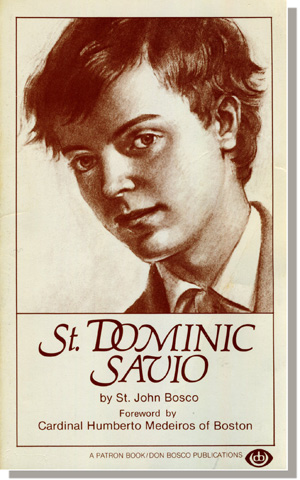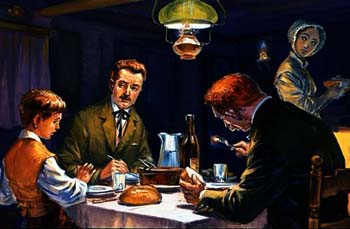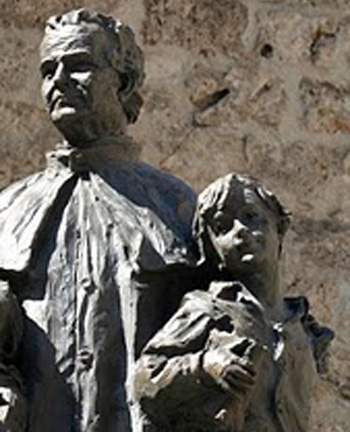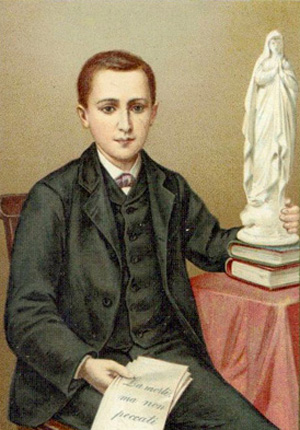Book reviews
 |
 |
 |
 |
 |
 |
 |
St. Dominic Savio: A Saint for Young People
Book Review of St. Dominic Savio by St. John Bosco
New York: Don Bosco Publications, 1979, 169 pp.
New York: Don Bosco Publications, 1979, 169 pp.

As an early aside, perhaps it is not deprived of significance that after reading this book, I discovered St. Dominic Savio’s feast day was only two days earlier, March 9. I must say this biography was difficult for me to put down, from beginning to end. Being only 170 pages, it can easily be read in one or two afternoons. It is also written simply and treats with delicacy matters of purity. As such, it is particularly suited for young people.
What is unique about this book is that, as mentioned in the Introduction, the reader can say “This is the life of a saint, written by a saint”! (p. 3)
As Don Bosco narrates the life of his disciple, the reader discovers that Dominic’s life was one of heroic sanctity. But not the kind of St. Augustine, St. Ignatius or even St. Thomas Aquinas – it was one of a simple peasant youth who took his studies seriously, obeyed his parents and superiors, and was zealous to save souls, particularly those of his schoolmates.
A well-mannered & obedient boy
Dominic was born in 1842 to “poor but upright peasants” close to Turin in Northern Italy. (p. 27) He was one of 10 children and, though they were poor, his parents made it a priority to give him a good Catholic education, which began in the home. As such he was a boy that was inclined to obedience and piety.

Dominic is repulsed by a stranger who disregards prayers and eats crudely at the family table
He was particularly concerned with saying mealtime prayers when eating together with his family and would even remind his parents if they had forgotten to say them. One example of his excellent manners is when his parents had invited a stranger to a meal, the man “sat down and hastily began to eat without the least sign of reverence.”
Disturbed by this, Dominic “slipped off to a corner.” When his parents approached the boy later and asked him why he had done that, he replied “I didn’t dare sit at table with someone who eats like an animal.” (p. 28)
The Oratory in Turin

St John Bosco directed Dominic, leading him on the path of sanctity
Dominic put his heart into his school work, observing all house rules diligently. He even asked his superiors to “correct him kindly if he slipped in his work.” He avoided the “scatter-brained” students, preferring “the company of those who gave good example, were studious, diligent and won their teachers’ approval. These boys became his fast friends.” (pp. 53-54)
The fight for purity
What is most remarkable about St. Dominic – especially for a young person – is his diligence in guarding the priceless treasure of purity.
Don Bosco tells of several instances in which other boys invited him to swim in the lake with them. At that time it was not uncommon for boys to swim without clothing. Knowing the grave offense to God he would commit should he join them, Dominic refused and reprimanded them.
The boys argued, “We’re not doing anything wrong, besides we cannot stand this heat.” Dominic replied: “If you can’t stand it now, how can you stand the horrible fires of hell – and you may well deserve them!” (p. 74)
His particular weapon to fight impurity was penance. He understood that in order to be like Our Lord, he must crucify the flesh to submit it to his will. Many times, the boy would carry out harsh penances, but when Don Bosco would discover it, he would forbid the harsher ones, and Dominic would obey.
The boy understood also that Don Bosco was the shepherd of his soul and, as such, knew how to get him to Heaven better than he did. This humble submission to his superior is also something admirable to contemplate, especially in our egalitarian times.
The Company of Mary Immaculate

Dominic’s handwritten resolution:
‘Death before sin’
Don Bosco gives the list of its rules, which include:
- To help our fellow students by kind admonitions and good example;
- To carry out our duties;
- To consecrate every Saturday to Our Lady and to make an act of piety in honor of her Immaculate Conception;
- To spend our free time doing useful things, good reading and prayer.
Caution: Progressivist corruption in this edition
After reading this book, I was encouraged to seriously imitate St. Dominic in my pursuit for virtue. I would recommend this reading for every young person in our day. However, I would caution younger readers (especially children) about this edition because there are serious concessions in it.
These bad parts can be avoided by skipping the Foreword, Introduction and chapter notes. In other words, one can avoid most of the progressivist corruptions of the book by simply reading what St. John Bosco wrote and not any of the later additions.
I say “most” of the corruptions because even the translation at times is progressivist-oriented: for example, the Sacraments are termed in the progressivist terminology: Sacrament of Reconciliation instead of the traditional Sacrament of Confession or Penance; Annointing of the Sick instead of Extreme Unction.
In the Introduction, Foreword and chapter notes, the manifestations of Progressivism are too numerous to list here, so I will leave it to the readers’ acumen. To help them sharpen their criteria, I recommend reading the book Revolution and Counter-Revolution, as well as our article on Liberals, Modernists & Progressivists.
Final thoughts
Since this is a book published in English by today’s Salesians, I suggest dismissing their concessions to Progressivism and instead focusing on the biography itself, which is truly a gem. Even though the notes are problematic, some of the information in them may be helpful for one who is not familiar with Dominic Savio or Don Bosco.
As with so many things in today’s Church infected with Progressivism, one must navigate through the murky waters of this book to find the truth. After separating the good from the evil, the reader will have learned about two saints – St. Dominic and St. John Bosco – and acquired two new friends in Heaven who can intercede for him in these troubled times.

Posted April 23, 2017
______________________
______________________
 Volume I |
 Volume II |
 Volume III |
 Volume IV |
 Volume V |
 Volume VI |
 Volume VII |
 Volume VIII |
 Volume IX |
 Volume X |
 Volume XI |
 Special Edition |


